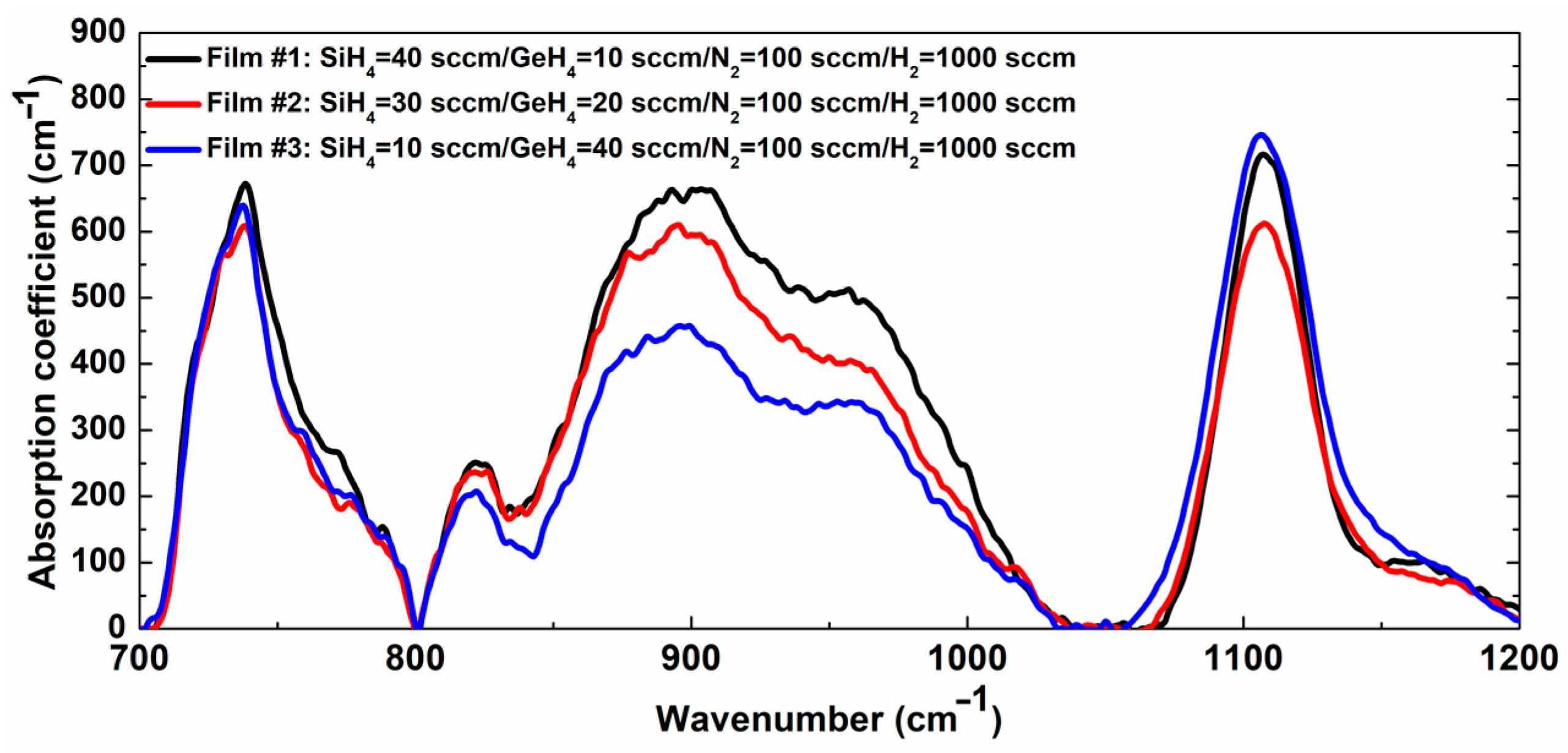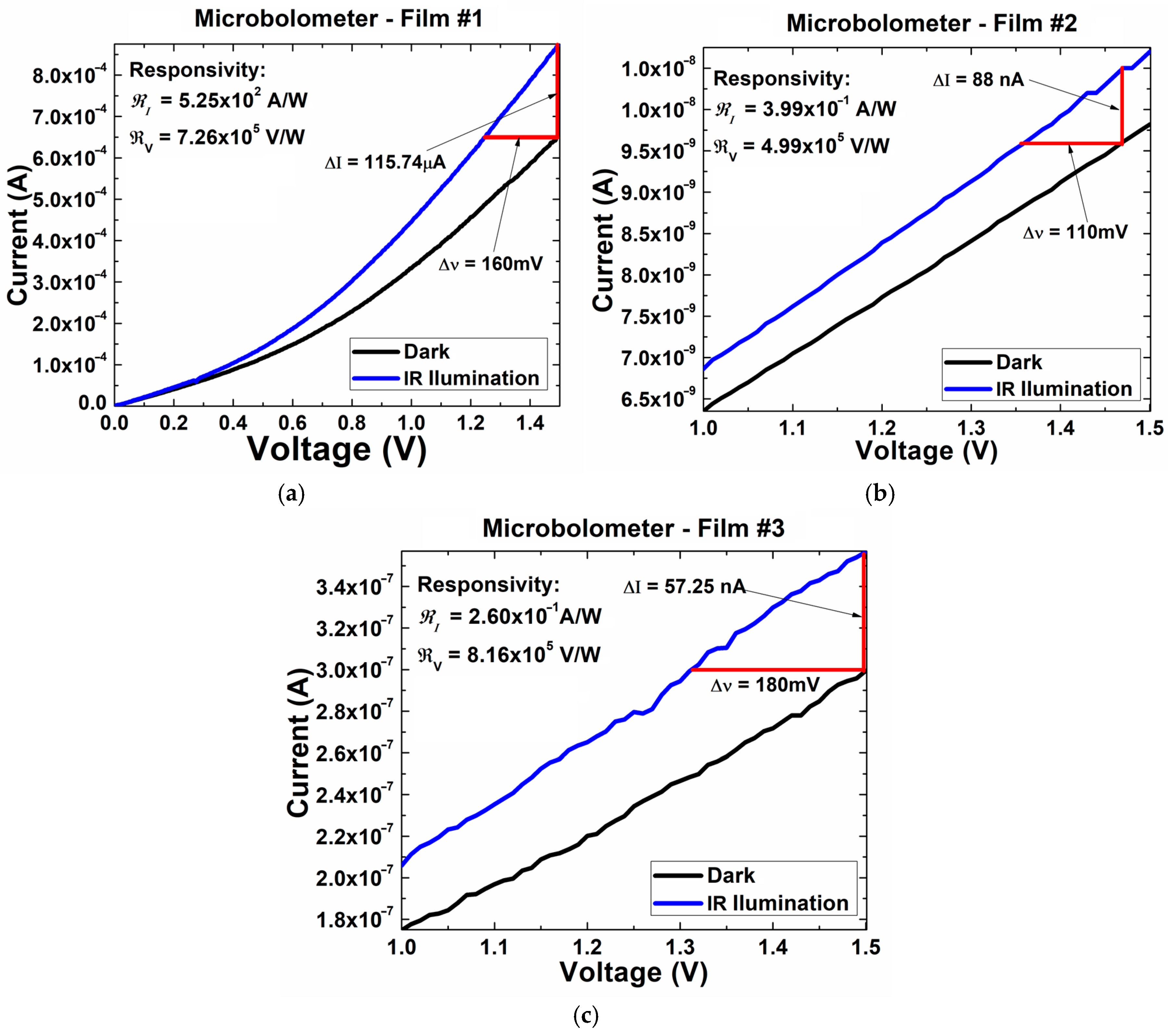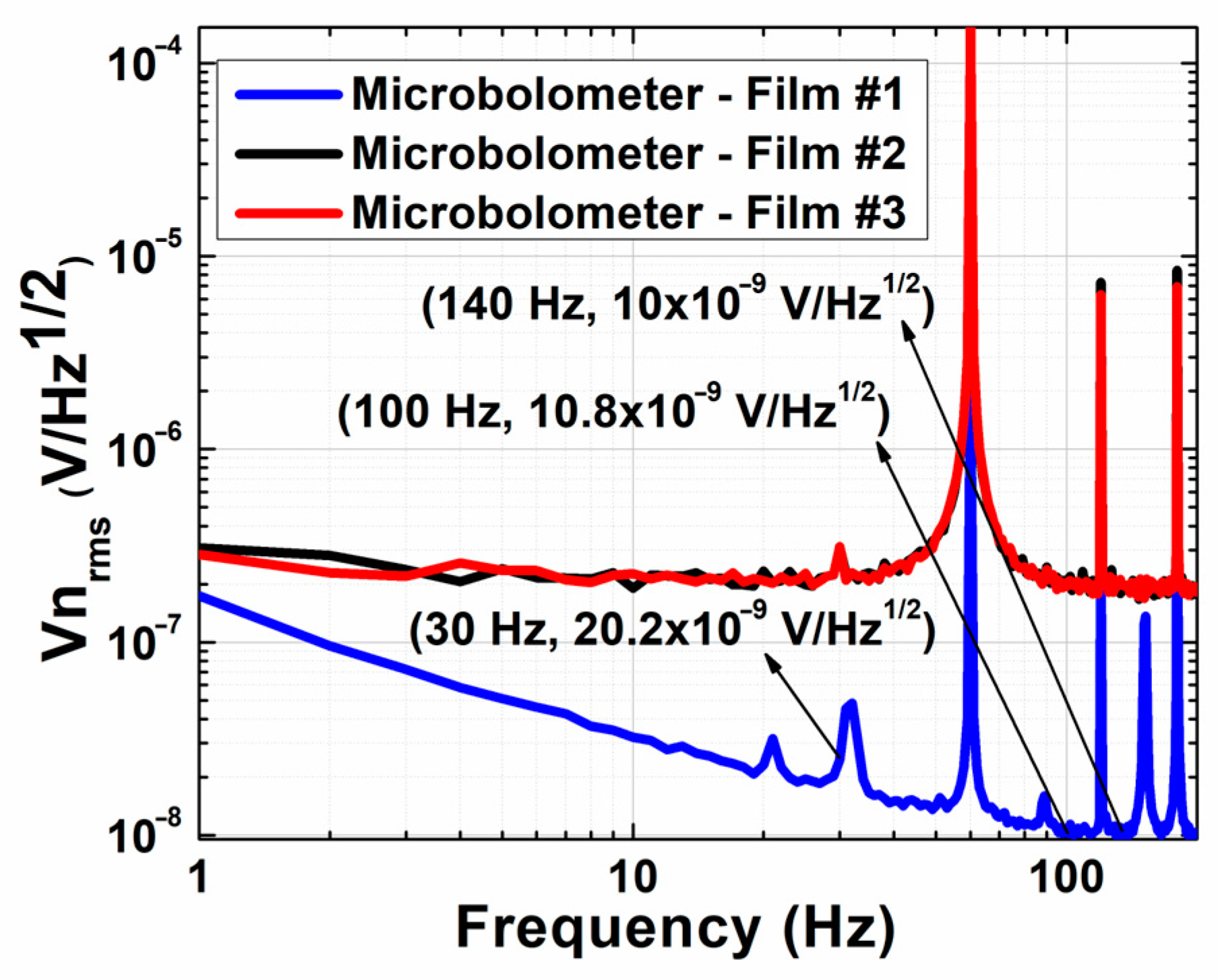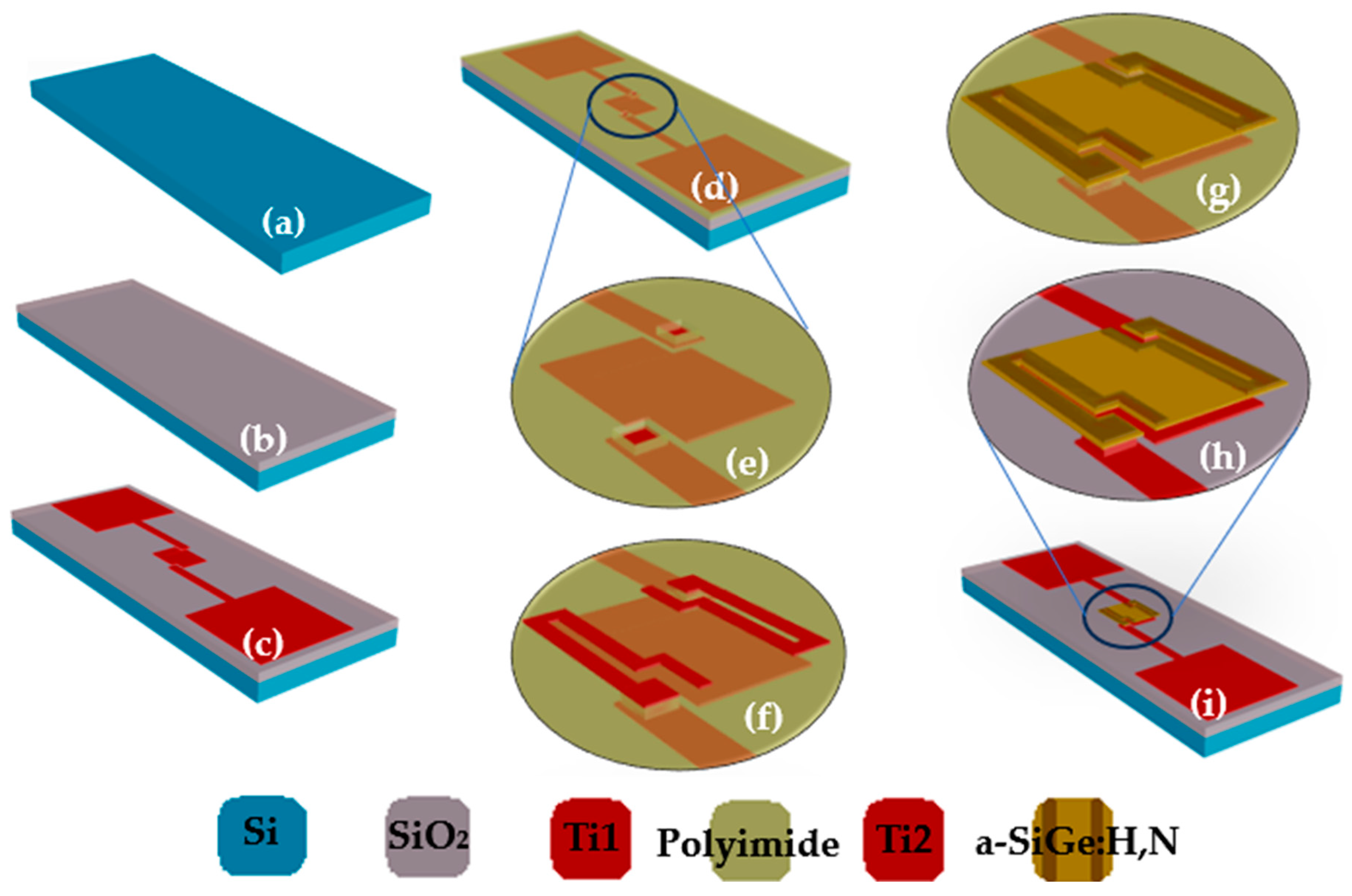Uncooled Microbolometers Based on Nitrogen-Doped Hydrogenated Amorphous Silicon-Germanium (a-SiGe:H,N)
Abstract
1. Introduction
2. Results and Discussion
2.1. Characterization of the Thermo-Sensing Films
2.2. Characterization of Micro-Bolometers
2.3. Responsivity ( )
2.4. Power Spectral Density (PSD)
2.5. Noise Equivalent Power (NEP)
2.6. Detectivity (D*)
2.7. Noise Equivalent Temperature Difference (NETD)
2.8. Resistance Versus Temperature (R(T))
3. Materials and Methods
3.1. Thermo-Sensing Film Deposition Conditions
3.2. Microbolometers Fabrication
4. Conclusions
Author Contributions
Funding
Data Availability Statement
Acknowledgments
Conflicts of Interest
References
- Hornberger, C. Application of Military Uncooled Infrared Sensors to Homeland Defense. Proc. SPIE 2002, 4708, 201–211. [Google Scholar] [CrossRef]
- Lahiri, B.B.; Bagavathiappan, S.; Jayakumar, T.; Philip, J. Medical Applications of Infrared Thermography: A Review. Infrared Phys. Technol. 2012, 55, 221–235. [Google Scholar] [CrossRef]
- Tissot, J.-L.; Trouilleau, C.; Fieque, B.; Crastes, A.; Legras, O. Uncooled Microbolometer Detector: Recent Developments at ULIS. Opto-Electron. Rev. 2006, 14, 25–32. [Google Scholar] [CrossRef]
- Yon, J.J.; Mottin, E.; Biancardini, L.; Letellier, L.; Tissot, J.L. Infrared Microbolometer Sensors and Their Application in Automotive Safety. Adv. Microsyst. Automot. Appl. 2003, 13, 137–157. [Google Scholar] [CrossRef]
- Dufour, D.; Le Noc, L.; Tremblay, B.; Tremblay, M.N.; Généreux, F.; Terroux, M.; Vachon, C.; Wheatley, M.J.; Johnston, J.M.; Wotton, M.; et al. A Bi-Spectral Microbolometer Sensor for Wildfire Measurement. Sensors 2021, 21, 3690. [Google Scholar] [CrossRef] [PubMed]
- Kusnierek, K.; Korsaeth, A. Challenges in Using an Analog Uncooled Microbolometer Thermal Camera to Measure Crop Temperature. Int. J. Agric. Biol. Eng. 2014, 7, 60–74. [Google Scholar] [CrossRef]
- Yu, L.; Guo, Y.; Zhu, H.; Luo, M.; Han, P.; Ji, X. Low-cost microbolometer type infrared detectors. Micromachines 2020, 11, 800. [Google Scholar] [CrossRef]
- Shin, C.; Kim, J.-K.; Oh, J.; Park, J.; Shin, H.-S. Noise Improvement of a-Si Microbolometers by the Post-Metal Annealing Process. Sensors 2021, 21, 7103. [Google Scholar] [CrossRef]
- Almasri, M.; Xu, B.; Castracane, J. Amorphous Silicon Two-Color Microbolometer for Uncooled IR Detection. IEEE Sens. J. 2006, 6, 293–300. [Google Scholar] [CrossRef]
- Piller, M.; Hiesberger, J.; Wistrela, E.; Martini, P.; Luhmann, N.; Schmid, S. Thermal IR Detection With Nanoelectromechanical Silicon Nitride Trampoline Resonators. IEEE Sens. J. 2023, 23, 1066–1071. [Google Scholar] [CrossRef]
- Hu, Y.; Lin, C.H.; Min, S.; Smith, R.L.; Roberts, S. Bolometric Arrays and Infrared Sensitivity of VO2 Films with Varying Stoichiometry. J. Optoelectron. Mater. Eng. 2017, 8, 345–353. [Google Scholar]
- Shin, C.; Pham, D.P.; Park, J.; Kim, S.; Lee, Y.-J.; Yi, J. Structure and Electrical Properties of Boron Doped Hydrogenated Mixed-Phase Silicon Films for Uncooled Microbolometer. Infrared Phys. Technol. 2018, 94, 103–111. [Google Scholar] [CrossRef]
- Kolahdouz, M.; Salemi, A.; Moeen, M.; Östling, M.; Radamson, H.H. Kinetic Modeling of Low Temperature Epitaxy Growth of SiGe Using Disilane and Digermane. J. Electrochem. Soc. 2012, 159, H478–H481. [Google Scholar] [CrossRef]
- Jung, J.; Kim, M.; Kim, C.-H.; Kim, T.H.; Park, S.H.; Kim, K.; Cho, H.J.; Kim, Y.; Kim, H.Y.; Oh, J.S. Improved responsivity of an a-Si-based micro-bolometer focal plane array with a SiNx membrane layer. J. Sens. Sci. Technol. 2022, 31, 366–370. [Google Scholar] [CrossRef]
- Forsberg, F.; Lapadatu, A.; Kittilsland, G.; Martinsen, S.; Roxhed, N.; Fischer, A.C.; Stemme, G.; Samel, B.; Ericsson, P.; Høivik, N.; et al. CMOS-integrated Si/SiGe quantum-well infrared microbolometer focal plane arrays manufactured with very large-scale heterogeneous 3-D integration. IEEE J. Sel. Top. Quantum Electron. 2015, 21, 2700111. [Google Scholar] [CrossRef]
- Moreno, M.; Jiménez, R.; Torres, A.; Ambrosio, R. Microbolometers based on amorphous silicon–germanium films with embedded nanocrystals. IEEE Trans. Electron Devices 2015, 62, 2120–2127. [Google Scholar] [CrossRef]
- Rogalski, A. Infrared Detectors; Gordon and Breach Science Publishers: Amsterdam, The Netherlands, 2000. [Google Scholar]
- Budzier, H.; Gerlach, G. Thermal Infrared Sensors: Theory, Optimisation and Practice; Wiley-VCH: Weinheim, Germany, 2011. [Google Scholar]
- Jimenez, R.; Moreno, M.; Torres, A.; Morales, A.; Ponce, A.; Ferrusca, D.; Rangel-Magdaleno, J.; Castro-Ramos, J.; Hernandez-Perez, J.; Cano, E. Fabrication of Microbolometer Arrays Based on Polymorphous Silicon–Germanium. Sensors 2020, 20, 2716. [Google Scholar] [CrossRef]
- Xu, Q.; Zhou, Z.; Tan, C.; Pan, X.; Wen, Z.; Zhang, J.; Zhou, D.; Sun, Y.; Chen, X.; Zhou, L.; et al. A Spectrally Selective Visible Microbolometer Based on Planar Subwavelength Thin Films. Nanoscale Adv. 2023, 5, 2054–2060. [Google Scholar] [CrossRef]
- Hai, M.L.; Cheng, Q.; Hesan, M.; Qu, C.; Kinzel, E.C.; Almasri, M. Amorphous SixGeyO1−x−y Thin Films for Uncooled Infrared Microbolometers. Infrared Phys. Technol. 2018, 95, 227–235. [Google Scholar] [CrossRef]
- Gao, Y.; Chen, H.; Xu, Y.; Sun, X.; Chang, B. Noise Research of Micro-Bolometer Array under Temperature Environment. Proc. SPIE Int. Symp. Photoelectron. Detect. Imaging 2011, 8193, 81930S. [Google Scholar] [CrossRef]
- Bartmann, M.G.; Sistani, M.; Luhmann, N.; Schmid, S.; Bertagnolli, E.; Lugstein, A.; Smoliner, J. Germanium Nanowire Microbolometer. Nanotechnology 2022, 33, 245201. [Google Scholar] [CrossRef] [PubMed]
- Cosme Bolaños, I. Experimental Study of Noise in Thermo-Sensing Films Based on Silicon-Germanium Deposited by Plasma for Application in Microbolometers. Master’s Thesis, National Institute of Astrophysics, Optics and Electronics (INAOE), Tonantzintla, Puebla, Mexico, 2008. [Google Scholar]
- Abdullah, A.; Koppula, A.; Alkorjia, O.; Almasri, M. Uncooled Two-Microbolometer Stack for Long Wavelength Infrared Detection. Sci. Rep. 2023, 13, 3470. [Google Scholar] [CrossRef] [PubMed]
- Adiyan, U.; Larsen, T.; Zárate, J.J.; Villanueva, L.G.; Shea, H. Shape Memory Polymer Resonators as Highly Sensitive Uncooled Infrared Detectors. Nat. Commun. 2019, 10, 4518. [Google Scholar] [CrossRef] [PubMed]
- Perić, D.; Livada, B.; Perić, M.; Vujić, S. Thermal Imager Range: Predictions, Expectations, and Reality. Sensors 2019, 19, 3313. [Google Scholar] [CrossRef]
- Velandia, O.; Moreno, M.; Zavala, R. Optimization of the Electrical Conductivity and Thermal Coefficient of Resistance (TCR) on Hydrogenated Amorphous Silicon–Germanium Films Doped with Nitrogen (a-SiGe:H,N) for Applications on High-Performance Infrared Detectors. In Proceedings of the 2023 IEEE Latin American Electron Devices Conference (LAEDC), Puebla, Mexico, 3–5 July 2023. [Google Scholar] [CrossRef]
- Chu, P.S.; Chen, H.L.; Ding, R.J. A Novel Linear-Logarithmic Readout Integrated Circuit with High Dynamic Range. Infrared Phys. Technol. 2019, 102, 103158. [Google Scholar] [CrossRef]
- Calleja Gómez, C.M. Fabrication and Characterization of UV Radiation Detectors Based on Silicon. Master’s Thesis, National Institute of Astrophysics, Optics and Electronics (INAOE), Tonantzintla, Puebla, Mexico, 2011. [Google Scholar]
- Alanís, A.; Díaz, D.; Reyes, C.; Zúñiga, C.; Torres, A.; Rosales, P.; Molina, J.; Hidalga, J.; Linares, M.; Aceves, M.; et al. PolyMEMS INAOE, a Surface Micromachining Fabrication Module and the Development of Microstructures for Residual Stress Analysis. In Proceedings of the 6th Ibero-American Congress on Sensor, IBERSENSORS, Sao Paulo, Brazil, 24–28 November 2008; Available online: https://www.researchgate.net/publication/312498987_PolyMEMS_INAOE_a_Surface_Micromachining_Fabrication_Module_and_the_Development_of_Microstructures_for_Residual_Stress_Analysis (accessed on 1 September 2024).
- Yan, W.; Shrestha, V.R.; Jeangros, Q.; Sefidmooye Azar, N.; Balendhran, S.; Ballif, C.; Crozier, K.B.; Bullock, J. Spectrally Selective Mid-Wave Infrared Detection Using Fabry–Pérot Cavity Enhanced Black Phosphorus 2D Photodiodes. ACS Nano 2020, 14, 13547–13556. [Google Scholar] [CrossRef]
- Abdel-Rahman, M.; Zia, M.; Alduraibi, M. Temperature-Dependent Resistive Properties of Vanadium Pentoxide/Vanadium Multi-Layer Thin Films for Microbolometer & Antenna-Coupled Microbolometer Applications. Sensors 2019, 19, 1320. [Google Scholar] [CrossRef]








| Microbolometer Films | Gases Flow Rates Used for Deposition (sccm) | Average Roughness (nm) | Voltage Responsivity (V/W) | Current Responsivity (A/W) | Room Temperature Resistance (Ω) |
|---|---|---|---|---|---|
| Film #1 | SiH4 = 40 sccm/GeH4 = 10 sccm/ N2 = 100 sccm/H2 = 1000 sccm | 4.51 | 7.26 × 105 | 5.25 × 102 | 2.76 × 103 |
| Film #2 | SiH4 = 30 sccm/GeH4 = 20 sccm/ N2 = 100 sccm/H2 = 1000 sccm | 5.68 | 4.99 × 105 | 3.99 × 10−1 | 1.57 × 108 |
| Film #3 | SiH4 = 10 sccm/GeH4 = 40 sccm/ N2 = 100 sccm/H2 = 1000 sccm | 8.40 | 8.16 × 105 | 2.60 × 10−1 | 5.72 × 106 |
| Microbolometer Film | Frequency () | ) | Room Temperature Resistance (Ω) | NEP ) | Detectivity ) | NETD (mK) |
|---|---|---|---|---|---|---|
| Film #1 | 30 | 20.2 × 10−9 | 2.78 × 10−14 | 1.80 × 109 | 45.15 | |
| 100 | 10.8 × 10−9 | 2.76 × 103 | 1.49 × 10−14 | 3.36 × 109 | 24.14 | |
| 140 | 10.0 × 10−9 | 1.38 × 10−14 | 3.63 × 109 | 22.35 | ||
| Film #2 | 30 | 313 × 10−9 | 6.28 × 10−13 | 7.96 × 107 | 1018 | |
| 100 | 196 × 10−9 | 15.7 × 109 | 3.92 × 10−13 | 1.28 × 108 | 637.38 | |
| 140 | 198 × 10−9 | 3.96 × 10−13 | 1.26 × 108 | 643.88 | ||
| Film #3 | 30 | 314 × 10−9 | 3.84 × 10−13 | 1.30 × 108 | 624.43 | |
| 100 | 194 × 10−9 | 5.72 × 106 | 2.38 × 10−13 | 2.10 × 108 | 186.93 | |
| 140 | 180 × 10−9 | 2.20 × 10−13 | 2.27 × 108 | 357.95 |
Disclaimer/Publisher’s Note: The statements, opinions and data contained in all publications are solely those of the individual author(s) and contributor(s) and not of MDPI and/or the editor(s). MDPI and/or the editor(s) disclaim responsibility for any injury to people or property resulting from any ideas, methods, instructions or products referred to in the content. |
© 2025 by the authors. Licensee MDPI, Basel, Switzerland. This article is an open access article distributed under the terms and conditions of the Creative Commons Attribution (CC BY) license (https://creativecommons.org/licenses/by/4.0/).
Share and Cite
Velandia, O.; Torres, A.; Morales, A.; Hernández, L.; Luna, A.; Monfil, K.; Flores, J.; Minquiz, G.M.; Jiménez, R.; Moreno, M. Uncooled Microbolometers Based on Nitrogen-Doped Hydrogenated Amorphous Silicon-Germanium (a-SiGe:H,N). Inorganics 2025, 13, 126. https://doi.org/10.3390/inorganics13040126
Velandia O, Torres A, Morales A, Hernández L, Luna A, Monfil K, Flores J, Minquiz GM, Jiménez R, Moreno M. Uncooled Microbolometers Based on Nitrogen-Doped Hydrogenated Amorphous Silicon-Germanium (a-SiGe:H,N). Inorganics. 2025; 13(4):126. https://doi.org/10.3390/inorganics13040126
Chicago/Turabian StyleVelandia, Oscar, Alfonso Torres, Alfredo Morales, Luis Hernández, Alberto Luna, Karim Monfil, Javier Flores, Gustavo M. Minquiz, Ricardo Jiménez, and Mario Moreno. 2025. "Uncooled Microbolometers Based on Nitrogen-Doped Hydrogenated Amorphous Silicon-Germanium (a-SiGe:H,N)" Inorganics 13, no. 4: 126. https://doi.org/10.3390/inorganics13040126
APA StyleVelandia, O., Torres, A., Morales, A., Hernández, L., Luna, A., Monfil, K., Flores, J., Minquiz, G. M., Jiménez, R., & Moreno, M. (2025). Uncooled Microbolometers Based on Nitrogen-Doped Hydrogenated Amorphous Silicon-Germanium (a-SiGe:H,N). Inorganics, 13(4), 126. https://doi.org/10.3390/inorganics13040126










